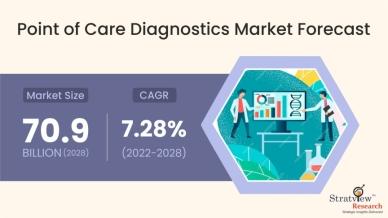"Market Drivers for Point of Care Diagnostics: What's Fueling the Growth?"

In the ever-evolving landscape of healthcare, Point of Care Diagnostics (POCD) has emerged as a transformative force, promising rapid and accurate medical testing at the patient's bedside. This market segment has experienced significant growth in recent years, and its trajectory continues upward. A confluence of technological advancements, increasing prevalence of chronic diseases, and the demand for immediate medical results has fueled the expansion of the Point of Care Diagnostics market. The point of care diagnostics market was estimated at US$ 36.6 billion in 2021 and is expected to grow at a CAGR of 7.28% during 2022-2028 to reach US$ ~70.9 billion in 2028.
Technological Advancements: One of the primary drivers of the POCD market’s growth is the rapid advancement in diagnostic technologies. Miniaturization of devices, coupled with sophisticated biosensor technologies, has enabled the development of portable and easy-to-use diagnostic tools. These innovations have not only enhanced the accuracy and reliability of tests but have also drastically reduced the time required to obtain results. From handheld devices to smartphone-integrated applications, the market is witnessing an influx of cutting-edge solutions.
Rising Prevalence of Chronic Diseases: The global rise in chronic diseases, such as diabetes, cardiovascular disorders, and infectious diseases like COVID-19, has necessitated the need for swift and accurate diagnostic tools. POCD meets this demand by allowing for immediate testing, thereby facilitating prompt interventions and personalized treatment plans. As the incidence of chronic diseases continues to climb, the POCD market is expected to expand correspondingly.
Market Expansion in Developing Countries: Developing countries, facing the dual burden of infectious diseases and non-communicable diseases, are embracing POCD technologies to address their healthcare challenges. These user-friendly and cost-effective diagnostic solutions are particularly beneficial in resource-limited settings, enabling healthcare providers to deliver timely and efficient medical services. This trend is fostering the growth of the POCD market in regions where traditional laboratory infrastructure is limited.
Regulatory Support and Strategic Alliances: The Point of Care Diagnostics market growth is further bolstered by supportive regulatory frameworks and strategic collaborations between healthcare organizations, research institutions, and industry players. Regulatory agencies are actively working to ensure the safety and efficacy of POCD devices, fostering confidence among both healthcare professionals and patients. Additionally, collaborations and partnerships between companies are driving innovations, leading to the development of more sophisticated and reliable diagnostic tools.
Conclusion: The Point of Care Diagnostics market's remarkable growth can be attributed to a synergy of technological innovation, increasing disease prevalence, expanding markets in developing countries, and collaborative efforts within the healthcare industry. As these factors continue to shape the landscape, POCD is poised to play a pivotal role in revolutionizing healthcare delivery, ensuring timely and accurate diagnoses that significantly enhance patient outcomes worldwide. As the market evolves, ongoing research, development, and strategic partnerships will be crucial in sustaining this growth trajectory and furthering the capabilities of Point of Care Diagnostics.
- Art
- Causes
- Crafts
- Dance
- Drinks
- Film
- Fitness
- Food
- Games
- Gardening
- Health
- Home
- Literature
- Music
- Networking
- Other
- Party
- Religion
- Shopping
- Sports
- Theater
- Wellness
- IT, Cloud, Software and Technology


